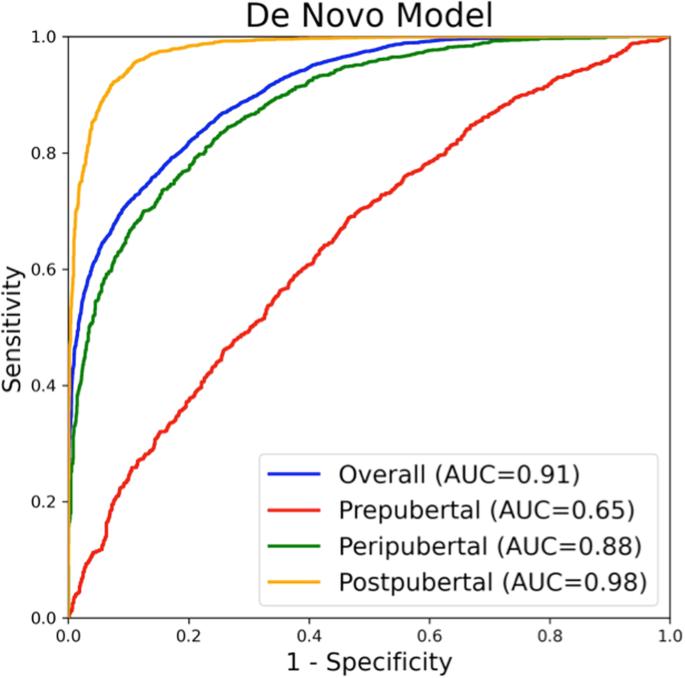Pediatric sex estimation using AI-enabled ECG analysis: influence of pubertal development
IF 12.4
1区 医学
Q1 HEALTH CARE SCIENCES & SERVICES
引用次数: 0
Abstract
AI-enabled ECGs have previously been shown to accurately predict patient sex in adults and correlate with sex hormone levels. We aimed to test the ability of AI-enabled ECGs to predict sex in the pediatric population and study the influence of pubertal development. AI-enabled ECG models were created using a convolutional neural network trained on pediatric 10-second, 12-lead ECGs. The first model was trained de novo using pediatric data. The second model used transfer learning from a previously validated adult data-derived algorithm. We analyzed the first ECG from 90,133 unique pediatric patients (aged ≤18 years) recorded between 1987–2022, and divided the cohort into training, validation, and testing datasets. Subgroup analysis was performed on prepubertal (0–7 years), peripubertal (8–14 years), and postpubertal (15–18 years) patients. The cohort was 46.7% male, with 21,678 prepubertal, 26,740 peripubertal, and 41,715 postpubertal children. The de novo pediatric model demonstrated 81% accuracy and an area under the curve (AUC) of 0.91. Model sensitivity was 0.79, specificity was 0.83, positive predicted value was 0.84, and the negative predicted value was 0.78, for the entire test cohort. The model’s discriminatory ability was highest in postpubertal (AUC = 0.98), lower in the peripubertal age group (AUC = 0.91), and poor in the prepubertal age group (AUC = 0.67). There was no significant performance difference observed between the transfer learning and de novo models. AI-enabled interpretation of ECG can estimate sex in peripubertal and postpubertal children with high accuracy.


利用人工智能心电图分析估测小儿性别:青春期发育的影响
人工智能心电图先前已被证明能准确预测成人患者的性别,并与性激素水平相关。我们旨在测试人工智能心电图预测儿童性别的能力,并研究青春期发育的影响。我们使用在儿科 10 秒 12 导联心电图上训练的卷积神经网络创建了人工智能心电图模型。第一个模型使用儿科数据从头开始训练。第二个模型使用的是先前经过验证的成人数据衍生算法的迁移学习。我们分析了 1987-2022 年间记录的 90,133 名独特儿科患者(年龄小于 18 岁)的首份心电图,并将队列分为训练数据集、验证数据集和测试数据集。对青春期前(0-7 岁)、青春期周围(8-14 岁)和青春期后(15-18 岁)的患者进行了分组分析。队列中男性占 46.7%,有 21,678 名青春期前儿童、26,740 名青春期前儿童和 41,715 名青春期后儿童。全新儿科模型的准确率为 81%,曲线下面积 (AUC) 为 0.91。整个测试队列的模型灵敏度为 0.79,特异度为 0.83,正预测值为 0.84,负预测值为 0.78。模型的判别能力在青春期后最高(AUC = 0.98),在围青春期年龄组较低(AUC = 0.91),在青春期前年龄组较差(AUC = 0.67)。迁移学习模型和自建模型之间没有明显的性能差异。人工智能解读心电图能准确估计围青春期和青春期后儿童的性别。
本文章由计算机程序翻译,如有差异,请以英文原文为准。
求助全文
约1分钟内获得全文
求助全文
来源期刊

NPJ Digital Medicine
Multiple-
CiteScore
25.10
自引率
3.30%
发文量
170
审稿时长
15 weeks
期刊介绍:
npj Digital Medicine is an online open-access journal that focuses on publishing peer-reviewed research in the field of digital medicine. The journal covers various aspects of digital medicine, including the application and implementation of digital and mobile technologies in clinical settings, virtual healthcare, and the use of artificial intelligence and informatics.
The primary goal of the journal is to support innovation and the advancement of healthcare through the integration of new digital and mobile technologies. When determining if a manuscript is suitable for publication, the journal considers four important criteria: novelty, clinical relevance, scientific rigor, and digital innovation.
 求助内容:
求助内容: 应助结果提醒方式:
应助结果提醒方式:


